
Antonio Salviati was an Italian glass manufacturer and founder of the Salviati family firm.
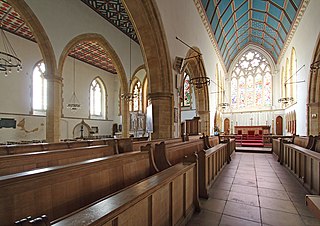
A hall church is a church with a nave and aisles of approximately equal height. In England, Flanders and the Netherlands, it is covered by parallel roofs, typically, one for each vessel, whereas in Germany there is often one single immense roof. The term was invented in the mid-19th century by Wilhelm Lübke, a pioneering German art historian. In contrast to an architectural basilica, where the nave is lit from above by the clerestory, a hall church is lit by the windows of the side walls typically spanning almost the full height of the interior.

Sir John Ninian Comper was a Scottish architect; one of the last of the great Gothic Revival architects.

St Matthew's Church, Westminster, is an Anglican church in Westminster, London. Located in the heart of the capital, close to the Houses of Parliament, Westminster Abbey and Church House, St Matthew's has been closely associated with the recovery of the Catholic heritage of the Church of England from its early days. One of the foremost leaders of that movement, Frank Weston, Bishop of Zanzibar, served at St Matthew's from 1916–1918.

St Cyprian's Church is a parish church of the Church of England in the Marylebone district of London. The church was consecrated in 1903, but the parish was founded in 1866. It is dedicated to Cyprian, a third-century martyr and bishop of Carthage and is near the Clarence Gate Gardens entrance to Regent's Park, off Baker Street. The present church was designed by Ninian Comper and is a Grade II* listed building.

Saint Augustine's, Kilburn, is a Church of England church in the area of Kilburn, in North London, England. Because of its large size and ornate architecture, it is sometimes affectionately referred to as "the Cathedral of North London", although the church is not a cathedral in any official sense.
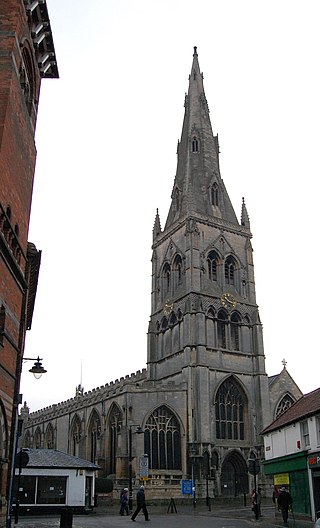
St Mary Magdalene Church, Newark-on-Trent is the parish church of Newark-on-Trent in Nottinghamshire, England. It is dedicated to Mary Magdalene and is the tallest structure in the town.

All Saints Pastoral Centre is a complex of buildings at London Colney on the southern outskirts of St Albans, Hertfordshire, England. It was built as a convent for the Anglican Society of All Saints Sisters of the Poor.

St. Stephen's is a former church building in Hampstead, London. It is sited on Rosslyn Hill at its junction with Pond Street, a steep slope adjacent to the Royal Free Hospital, and held up to 1,200 worshippers at its peak.

St Peter's Church is in the village of Finsthwaite, Cumbria, England. It is an active Anglican parish church in the deanery of Windermere, the archdeaconry of Westmorland and Furness, and the diocese of Carlisle. Formerly part of the Leven Valley benefice, together with St Anne Haverthwaite and St Mary Staveley-in-Cartmel, it is now part of the Cartmel Peninsula Team Ministry. The church is recorded in the National Heritage List for England as a designated Grade II* listed building. St Peter's was designed by the Lancaster partnership of Paley and Austin. They were the winners of a competition to design "mountain chapels" organised by the Carlisle Church Extension Society in 1873. The authors of the Buildings of England series describe the church as "a brilliant essay", and write that "one would have to search far and search long in England to find village churches to vie with" this and two other Austin and Paley churches, Torver and Dolphinholme. The church stands to the southeast of the village.
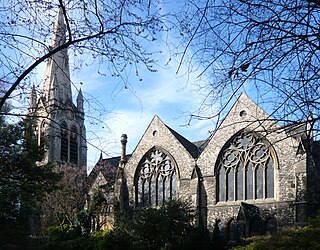
St Jude's Church, Courtfield Gardens, Kensington, London, was designed by architects George Godwin and Henry Godwin, and built between 1867 and 1870; the tower and spire were constructed in 1879. It was built on the northern portion of Captain Robert Gunter's estate. The project was overseen by Reverend J. A. Aston, and financed by John Derby Allcroft, a wealthy glove manufacturer. The construction, not including the tower, pulpit, font and organ cost £11,300, and was undertaken by Myers & Sons.
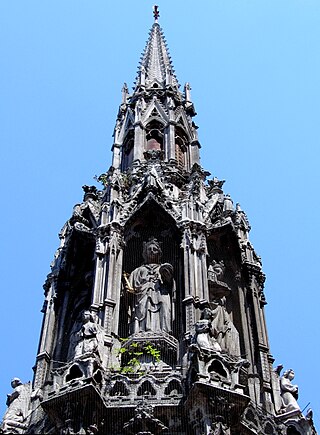
Thomas Earp (1828–1893) was a British sculptor and architectural carver who was active in the late 19th century. His best known work is his 1863 reproduction of the Eleanor Cross which stands at Charing Cross in London. He specialised in sculpture for Gothic Revival churches and worked closely with the architect George Edmund Street in the 1860s and 1870s.

St Mary Magdalene, Richmond, in the Anglican Diocese of Southwark, is a Grade II* listed parish church on Paradise Road, Richmond, London. The church, dedicated to Jesus' companion Mary Magdalene, was built in the early 16th century but has been greatly altered so that, apart from the tower, the visible parts of the church date from the 18th, 19th and early 20th centuries.

St James Church is a Church of England church in School Lane, Quedgeley, Gloucester, Gloucestershire, England. It was designated as a Grade II listed building in January 1955.

St John the Baptist, Pinner, is an Anglican church in Church Lane, Pinner, Middlesex.

The Anglican Church of St Mary Magdelene in Exford, Somerset, England was built in the 15th century. It is a Grade II* listed building.
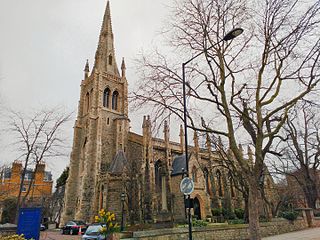
St Mark's Church, Hamilton Terrace, is an Anglican church in the St John's Wood neighbourhood of the City of Westminster, London. The building was completed by 1847 and was badly damaged in an unexplained fire on 26 January 2023. It is located at the intersection of Abercorn Place and Hamilton Terrace.

St Peter-in-Ely or St Peter's Church, Ely, is a Church of England proprietary chapel in Ely, Cambridgeshire, England, located on Broad Street. The chapel is in the Diocese of Ely and follows the Anglo-Catholic or high-church tradition of the Church of England.

The Church of St Mary in the Baum or Church of St Mary-in-the-Baum is a church in the town of Rochdale, Greater Manchester, England. Commissioned in 1738, and opened in 1742 as a chapel of ease, the chapel was extended in the 19th century. In the very early 20th century the church authorities determined to construct a new building and they commissioned Ninian Comper to undertake the task. Comper designed a completely new church to an unusual plan, due to the constriction of the urban site. He incorporated elements of the original chapel into the new design.
Daniel Bell (1840–1915) was a British church decorative artist and sculptor born in Silton, Dorset and died in Willesden.




























